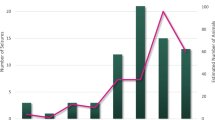Abstract
By any standard, Mato Topé, second chief of the Mandans, was a remarkable man. Known to the whites as Four Bears, he was the most prominent Indian of his day on the upper Missouri River. He was without peer as a warrior, but he was also a husband, father, artist, and ceremonial leader. The American artist George Catlin described him as an “extraordinary man,” handsome, generous, and brave, “the most popular man in the nation.”1 The life of Four Bears, as recorded by himself and by visiting artists, and his death, as recorded by fur trader Francis Chardon, illustrate the warrior culture of the Plains Indians and the sudden collapse of an entire society amid the horrors of a smallpox epidemic.
Access this chapter
Tax calculation will be finalised at checkout
Purchases are for personal use only
Preview
Unable to display preview. Download preview PDF.
Similar content being viewed by others
Notes
George Catlin, Letters and Notes on the Manners, Customs, and Conditions of North American Indians. 2 vols. (London: Author, 1844), 1:145.
W. Raymond Wood and Thomas D. Thiessen, eds., Early Fur Trade on the Northern Plains: Canadian Traders among the Mandan and Hidatsa Indians, 1738–1818 (Norman: University of Oklahoma Press, 1985);
James P. Ronda, Lewis and Clark among the Indians (Lincoln: University of Nebraska Press, 1984);
Reuben G. Thwaites, ed., Original Journals of the Lewis and Clark Expedition, 1804–1806. 7 vols. (New York: Dodd, Mead, 1904–05), esp. 6:80–120.
John C. Ewers, “Early White Influence upon Plains Indian Painting,” in his Indian Life on the Upper Missouri (Norman: University of Oklahoma Press, 1968), 98–116.
The robe is in the Peabody Museum of Archaeology and Ethnology at Harvard University. Evan M. Maurer, et al., Visions of the People: A Pictorial History of Plains Indian Life (Minneapolis Institute of Arts, 1992), 188.
Michael K. Trimble, “The 1832 Inoculation Program on the Missouri River,” in John W. Verano and Douglas H. Ubelaker, eds., Disease and Demography in the Americas (Washington, D.C.: Smithsonian Institution, 1992), 257–65.
Russell Thornton, American Indian Holocaust and Survival: A Population History since 1492 (Norman: University of Oklahoma Press, 1987), 95–99.
Author information
Authors and Affiliations
Editor information
Editors and Affiliations
Copyright information
© 1996 BEDFORD BOOKS of St. Martin’s Press
About this chapter
Cite this chapter
Calloway, C.G. (1996). The Life and Death of Four Bears. In: Calloway, C.G. (eds) Our Hearts Fell to the Ground. The Bedford Series in History and Culture. Palgrave Macmillan, New York. https://doi.org/10.1007/978-1-137-07646-5_5
Download citation
DOI: https://doi.org/10.1007/978-1-137-07646-5_5
Publisher Name: Palgrave Macmillan, New York
Print ISBN: 978-1-349-61348-9
Online ISBN: 978-1-137-07646-5
eBook Packages: Palgrave History CollectionHistory (R0)




